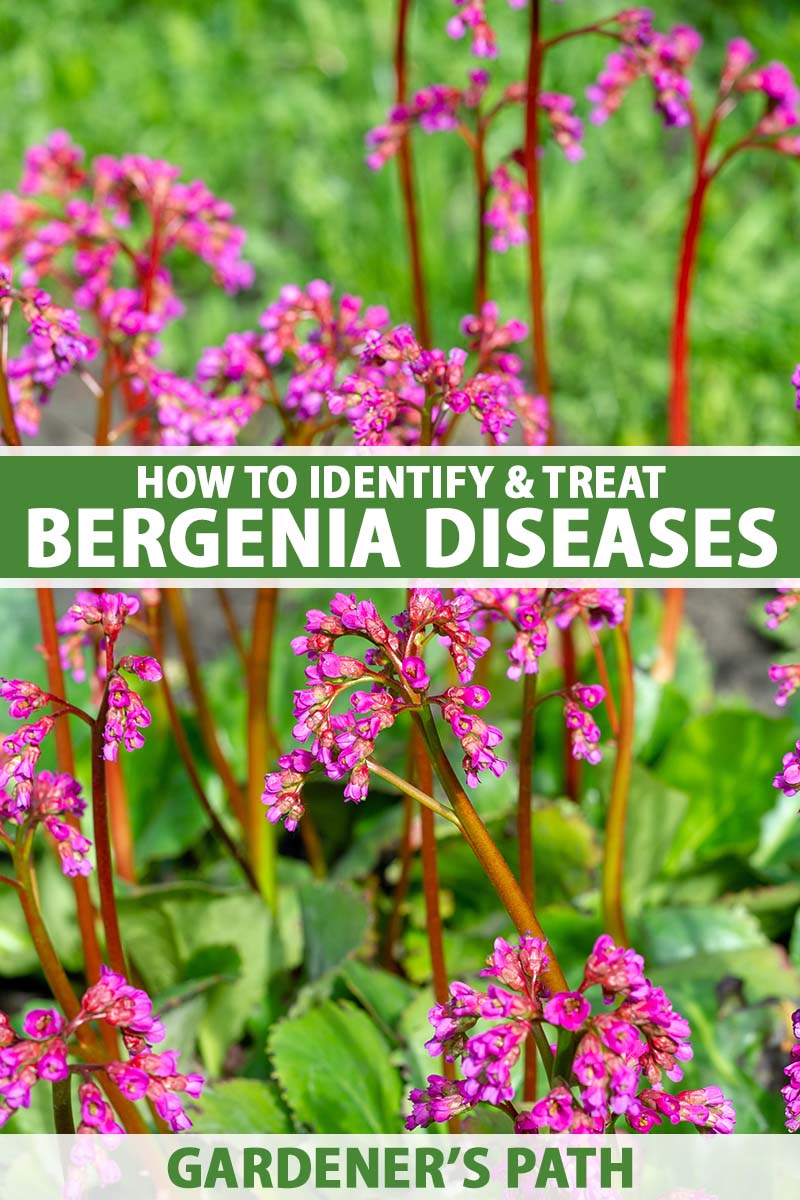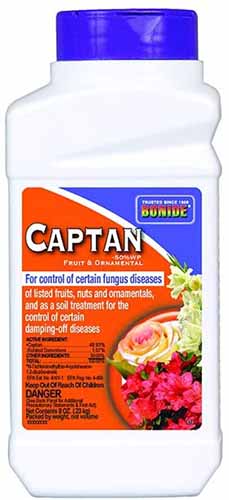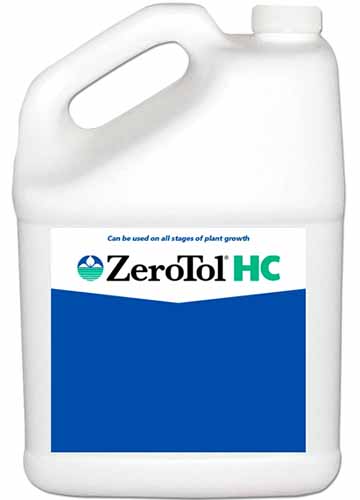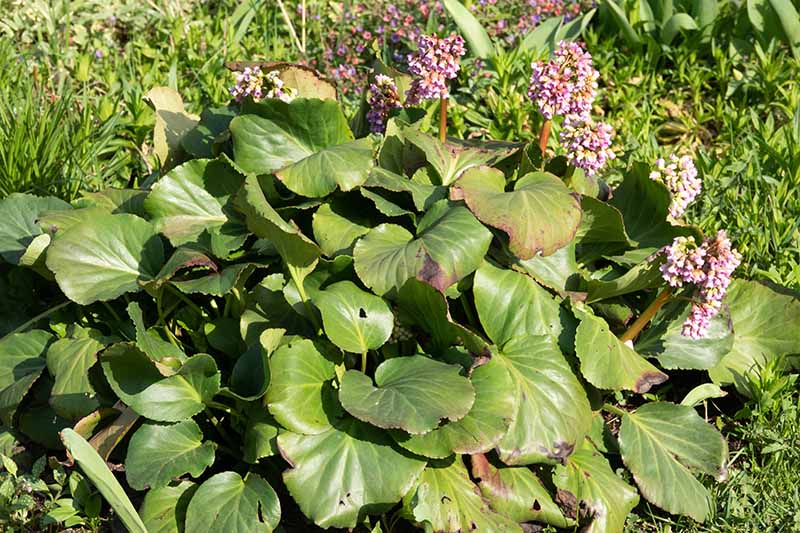In fact, members of this genus are widely studied for their natural ability to resist fungi, because they produce antifungal chemicals. This would make it seem like you never have to worry about disease in bergenia… But you know how fungi can develop resistance to synthetic fungicides? Resistance does not necessarily imply immunity, and the same thing can happen with the chemicals that plants make to defend themselves. We link to vendors to help you find relevant products. If you buy from one of our links, we may earn a commission. In this guide, we will cover the primary diseases that may affect bergenia, so you know what to look for and how to treat them. The most common disease to affect Bergenia species initially manifests as spots on the leaves. In rare instances, these plants can also succumb to crown or rhizome rot.
Anthracnose (Fungal Leaf Spots)
Leaf infections in bergenia are typically referred to as “fungal leaf spots.” However, my curiosity about plant diseases led me to take a deep dive into the scientific literature on bergenia, to find more information on what organisms infect these plants (my idea of a good time), and to share it with you!
Identifying the Main Pathogen
I’ll spare you all the gory details, but molecular genetic biological detective work indicates that anthracnose (Colletotrichum spp.) is the primary pathogen of bergenia plants. That is unfortunate, since this fungus may attack a wide range of hosts and causes symptoms that include crown and root rot, loss of leaves, blight on blossoms, and fruit rot. A groundbreaking study by the German plant pathologists Nirenberg and Gerlach examined outbreaks of leaf spots on bergenia plants in Berlin and other parts of Germany. They identified C. acutatum as the source of these infections. This species is comprised of different groups, and according to an article by Sreenivasaprasad and Talhinhas in Molecular Plant Pathology, isolates in group A4 may infect bergenia, as well as strawberries, walnuts, tomatoes, apples, olives, camellias, rhododendrons, and numerous other plants. That is bad news, since a fungus that is so widespread is much more likely to be found in your area and able to infect your plants. The species of fungi that may attack bergenia are widespread in Europe, and strains that are found in the US, Israel, and New Zealand are highly similar! This suggests that they may have all spread initially from a central source.
Symptoms and Treatment
The first symptoms you will typically notice are dark lesions on the leaves or stems. If the fungus thrives, it will produce pink masses of spores in the center of the lesions. This disease is a particular problem at temperatures ranging from 75 to 85°F. Treatments for anthracnose on bergenia have not been widely studied, since this plant is not a major commercial crop. However, knowing that the same pathogen causes anthracnose on strawberries gives us useful information to draw from for its control.
Sanitation
First, cut off all of the infected leaves and stems and discard them. Clean your pruning shears between uses with 70 percent rubbing alcohol or 10 percent bleach. Make sure to dispose of all of the plant debris from your garden. Do not put it in your compost pile.
Additional Types of Leaf Spots
There are some more obscure fungal diseases that may affect bergenia, but you are not likely to encounter them in your garden. Bonide Captan Liquid Fungicide Spray the plants at 10- to 14-day intervals as long as there are signs of infection. One important thing to note is that while this chemical will keep anthracnose from spreading to other plants, it will not cure plants that are already infected. Another product you can use is ZeroTol HC. ZeroTol HC It is a combination of hydrogen peroxide and peroxyacetic acid that kills bacteria and fungi on contact. You can buy ZeroTol HC from Arbico Organics. Spray daily for three consecutive days as soon as your plants show signs of disease. After that, spray weekly. Weekly sprays are also recommended to prevent infection when temperatures are in the optimal range.
Biofungicides
One wonderful quirk of microbiology is that there are microbes out there that will kill other ones! Some of the most effective strains are sold as biofungicides. One such product that is commonly used to treat anthracnose is CEASE Biological Fungicide. It is composed of an extensively studied strain of the bacterial species Bacillus subtilis. CEASE Biological Fungicide You can find CEASE available from Arbico Organics. You will get the best results if you treat at the first sign of infection. Spray as directed and repeat every seven days or as needed. If the disease is really entrenched, you can spray more frequently, or use the higher rate recommended on the label for ornamental plants, since you will not be consuming your bergenia! Learn more about how to use Bacillus subtilis in our guide. The German study referenced above identified another type of Colletotrichum from lupine plants (C. lupinii var. setosum) that is less aggressive and induces different kinds of symptoms on bergenia. C. lillacola causes a dreadful infection of Bergenia ligulata in India, but this species is not commonly grown in the US. Scientists in France identified the fungal pathogen Pilidium concavum from infected B. crassifolia leaves. While this pathogen can attack a wide array of plants, this was the first report of its ability to infect bergenia. The fungus has been isolated in the US, Europe, Brazil, China, and Iran. It is also known as tan-brown rot and causes small, round, water-soaked spots on leaves and sometimes stems as well.
Crown Rot/Rhizome Rot
Anthracnose is well known to also manifest as the dreaded crown rot, which causes the collapse and death of plants. This condition is also known as rhizome rot in bergenia. It is rarely a problem with these plants, unless you put mulch over their crowns. Since crown rots are usually fatal by the time your plant shows symptoms, your best bet is to purge infected plants from your garden. Another complication of crown rots is that collapsing plants look similar even when the damage is caused by very different types of pathogens. The water mold Phytophthora also commonly causes crown rot, but it can take a lab test to distinguish the source. It’s not worth it in this case, since it is extremely difficult to save a plant once it has contracted crown rot. Read more about identifying and treating crown rot here.
Bergenia Resists Most Infections
While anthracnose can attack bergenia plants, these beauties contract diseases much more rarely than other ornamental plants. Keep an eye out for spots on the leaves, avoid putting mulch on the crowns, and your plants should thrive for years. In the unfortunate event that you do see spots, treating your plants at the first sign of infection may save them, and should prevent the disease spreading around your garden. Have you encountered any diseases on your bergenia plants? If so, let us know how they fared in the comments section below. And for more information about growing bergenia in your garden, check out these guides next:
How to Grow and Care for Bergenia Flowers25 of the Best Bergenia Cultivars for the GardenHow to Identify and Control Bergenia Pests




